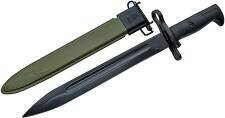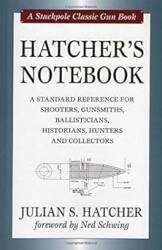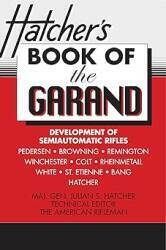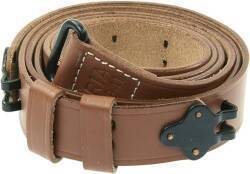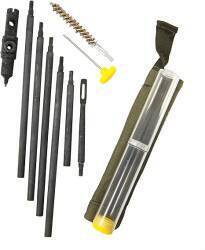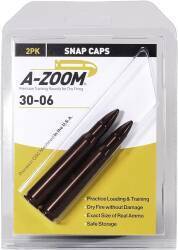
The .30-06 Springfield Cartridge
.30-06 Springfield
The U.S. Government's Springfield Armory developed a new .30 caliber cartridge in the early years of the 1900s to replace the poorly performing .30-03, 6mm Lee Navy, and .30-40 Krag (a.k.a. .30 US Army) cartridges. This new cartridge, standardized in 1906 and known as the .30-06 Springfield, was the U.S. military's main rifle ammo until the M14 rifle in 7.62x51 mm NATO was introduced in 1957.

.30-06 Springfield cartridges with M1 Garand en bloc clips.
Sweeping changes were underway in cartridge and rifle design. The propellant had changed from black powder to smokeless powder. The .30-40 Krag round was developed in the early 1890s to give the U.S. military a smokeless powder cartridge. This replaced the .45-70 cartridge, which heaved a fairly enormous .45 caliber 405 grain (26.2 gram) projectile using 70 grains (4.5 grams) of black powder.
The 7.62x51mm NATO round can reach a range of 1600 yards by lofting to a maximum elevation of less than 20 yards along its trajectory. To reach the same range, the .45-70 has to be lobbed over 80 yards above the straight-line path. See this page for details, including this plot of the trajectories.
Smokeless powder was about three times as powerful as an equal mass of black powder, producing higher muzzle velocity and a flatter trajectory. The French Lebel Model 1886 rifle was the first military rifle using smokeless powder ammunition.

Left:
7.62x25mm Tokarev
Center:
7.62x39mm
Right:
7.62x54R
The 7.62x25mm Tokarev round at left, used in pistols and
submachine guns, has a very blunt bullet.
The other two, rifle rounds, have far more aerodynamic
spitzer type bullets.
It wasn't just chemistry — aerodynamics and ballistics were involved. In 1898 the French again came out with a new development, a pointed bullet. The idea that seems obvious now but it was novel at the time as cartridges had only very recently replaced spherical bullets manually loaded on top of wadding and powder. The pointed nose had less aerodynamic resistance, and the overall shape had higher sectional density, the ratio of an object's mass to its cross-sectional area. Higher sectional density leads to better external ballistics (the flight through the air), and other things being equal, greater penetration in the terminal ballistics.
The shape came to be called spitzer, from the German word for "pointed bullet", Spitzgeschoss. The French bullet design of 1898 was followed by a German version in 1905, the U.S. .30-06 Springfield in 1906, the Russian Лёхая Пуля or Lyokhaya Pulya in 1908, and the British Mark VII in 1914. Pointed bullets had caught on.
And, of course, metallurgy became important. The gun's receiver and barrel obviously had to be stronger to contain the higher pressures of smokeless powder. The ammunition's case also had to be strong enough to withstand increased pressure and then be yanked from the chamber by the extractor and kicked aside with the ejector so the next round could be automatically stripped from the stack in the magazine and slammed into place. Finally, the bullet's jacket and its binding to the lead core had to withstand the rapid acceleration through the rifled barrel.
The U.S. .30-03, 6mm Lee Navy, and .30-40 Krag cartridges might be seen as interim designs on the way from black powder to smokeless powder cartridges. The Springfield .30-06 design of 1906 worked well enough for 50 years of military service and continued use today.
Development Sequence: .30-06 — .30 M1 — .30 M2
The .30-06 Springfield case is specified as shown here, with a case volume of 4.43 ml. It is intended to contain a pressure up to 58,740 psi (405 MPa) when contained within a properly shaped and sized chamber with a strong bolt locked shut behind it.
The original .30-06 cartridge had a bullet weighing 150 grains (9.72 grams). This bullet had a sharp point, a core made of 39 parts lead to 1 part tin, and a cupro-nickel jacket. It had a muzzle velocity of 1700 feet per second when fired from the M1903 Springfield rifle. See "Hatcher's Notebook", by Julian S Hatcher, Major General, U.S. Army, retired, 1947, for lots of details and anecdotes of the ammunition testing and evaluation processes.

.30-06 Springfield cartridge, all dimensions in mm.
"Hatcher's Notebook" is surprisingly entertaining. You would expect a U.S. Army officer involved in ordnance testing and design to be cautious to the point of stuffiness. But his book is full of stories that start with his wondering how far he could shoot a rifle along a beach, or what really happens when you shoot typical rounds in typical firearms when their barrel has been obstructed, or what would really happen if you shot a powerful rifle straight up. That last one led to a lot of involved testing, and they finally managed to set up a system in which they could retrieve the bullets returning to Earth. He sounds like he would have been interesting to know, although a little dangerous to have as a neighbor.
Further aerodynamic improvements were needed, as the .30-06 was found to have disappointing performance when compared to what would seem to be similar ammo. The original .30-06 bullet had a spitzer type pointed nose, but its tail was blunt — it was pointed in the front but just a squared-off cylinder in the rear. A vacuum is created behind the projectile, pulling it back and slowing it. A slight taper at the rear can reduce that drag. Tapered "boat tail" bullets were tested, in tapers from 2° to 12°. A taper of 9° was found to give the best performance.
In 1925, the Type E 9° boat-tailed bullet was adopted. This had been found to require a much harder core, 7 parts lead to 1 part antimony, and a jacket of gilding metal, a form of brass containing 95% copper and 5% zinc. It weighed 174.5 grains (11.3 grams).
Many tests and changes were made in the powder charge, to get the desired muzzle velocity with this heavier bullet while keeping the chamber pressure within an acceptable range. The resulting load had a muzzle velocity of 2640 feet per second, or 2595 feet per second at 78 feet. A .30-06 case with this load and the Type E 9° bullet became the .30 caliber M1 cartridge in 1925.
Things can get confusing with the use of the same designation
for completely different things!
M1 can refer to this .30 caliber cartridge,
to the
M1 Garand rifle,
the
M1 Carbine,
the
M1 helmet,
the
M1 mortar,
today's
M1 Abrams main battle tank,
and
more.
Similarly, M2 can refer to the following cartridge
design,
the
.50 caliber machine gun,
today's
M2 Bradley infantry fighting vehicle,
and
more.
At this point the government was sitting on a supply of about two billion rounds of the .30-06 ammunition, a supply built up during the World War. The Army, National Guard, and civilian rifle ranges were instructed to shoot up the older stock first.
It took eleven years, until 1936, for the old ammo to be used up and the M1 ammo to start appearing at the rifle ranges. The unpleasant surprise was that the M1 cartridge had significantly greater range, carrying past the marked danger zones of existing rifle ranges.
So, the National Guard Bureau asked the War Department to produce some ammo with some of the characteristics of the old .30-06 design. The resulting round had noticeably lower recoil (more of an issue with bolt-action rifles like the M1903 Springfield) and weighed less, allowing more rounds to be carried in the same weight.
The resulting throttled-back M1 became standardized as Cartridge, Ball, Caliber .30 M2 in 1940. Tin and antimony were getting scarce by then, and the lower performance bullet could be made of pure lead with the same gilding jacket. The lead was actually "secondary lead", reclaimed from batteries and other sources, so it wasn't really pure lead and contained some varying types and amounts of hardening material.
Then armor-piercing M2 was introduced. As Hatcher wrote, "In our own Army, the tendency is definitely to use armor piercing ammunition for everything, and to do away with plain ball. The Armor Piercing Ammunition that we use now is nearly identical with that developed immediately after World War I by Col. Clay, known as the M 1922."
| Type | Bullet Weight | Muzzle Velocity | Velocity at 53' / 16m | Velocity at 78' / 24m | Muzzle Energy | ||||
| Grains | Grams | fps | m/s | fps | m/s | fps | m/s | foot-pounds | |
| .30-06 | 150.0 | 9.72 | 2700 | 823 | 2655 | 809 | 2640 | 805 | 2429 |
| .30 M1 | 174.5 | 11.3 | 2647 | 807 | 2620 | 799 | 2600 | 792 | 2675 |
| .30 M2 | 152.0 | 9.85 | 2805 | 855 | 2755 | 840 | 2740 | 835 | 2656 |
| .30 Armor Piercing M2 | 168.5 | 10.9 | 2775 | 846 | 2730 | 832 | 2715 | 828 | 2780 |
"Hatcher's Notebook" contains the data shown in the following ballistic table.
| Comparison of .30 caliber cartridges | |||||||||||||||||
| Range, yards |
Angle of elevation, minutes | Time of flight, seconds | Maximum ordinate feet | Angle of fall, minutes | |||||||||||||
| .30-06 | M1 | M2 | M2 AP | M1 | M2 | M2 AP | M1 | M2 | M2 AP | M1 | M2 | M2 AP | |||||
| 100 | 2.6 | 2.7 | 2.4 | 0.12 | 0.12 | — | — | 2.7 | 3.4 | ||||||||
| 200 | 5.2 | 5.4 | 5.1 | 5.1 | 0.25 | 0.25 | 0.24 | 0.30 | 0.3 | 0.3 | 6.1 | 6.8 | 5.7 | ||||
| 300 | 8.3 | 8.4 | 8.1 | 0.39 | 0.38 | 0.60 | 0.6 | 10.1 | 10.1 | ||||||||
| 400 | 11.7 | 11.8 | 11.5 | 11.5 | 0.54 | 0.53 | 0.52 | 1.17 | 1.2 | 1.2 | 14.9 | 13.5 | 14.5 | ||||
| 500 | 15.8 | 15.9 | 15.5 | 0.70 | 0.70 | 2.01 | 1.8 | 20.3 | 20.3 | ||||||||
| 600 | 20.7 | 20.3 | 20.3 | 19.6 | 0.88 | 0.89 | 0.87 | 3.09 | 3.0 | 3.0 | 27.3 | 30.4 | 29.7 | ||||
| 700 | 26.3 | 25.3 | 26.0 | 1.07 | 1.11 | 4.56 | 5.1 | 35.8 | 40.5 | ||||||||
| 800 | 32.4 | 30.7 | 32.4 | 30.7 | 1.27 | 1.35 | 1.30 | 6.45 | 7.2 | 6.9 | 46.2 | 57.4 | 54.0 | ||||
| 900 | 39.8 | 36.8 | 40.2 | 1.50 | 1.62 | 9.00 | 10.8 | 74.3 | 74.3 | ||||||||
| 1000 | 48.3 | 43.5 | 49.3 | 46.2 | 1.75 | 1.91 | 1.82 | 12.30 | 15.3 | 13.5 | 95.9 | 94.5 | 90.1 | ||||
Here are the government's engineering drawings for the Cartridge, Ball, Caliber .30 M2 — the case, the bullet, and the entire cartridge.

Case for caliber .30 Service Cartridge.

Bullet, Ball, caliber .30 M2.

Cartridge, Ball, cal .30 M2 (Gilded) and M2 alternative (Steel Socketed).
New M1 Garand rifle barrels are not ready to fire immediately upon being threaded into the receiver and assembled into a complete gun. The chamber must be reamed into its final shape and dimensions using a precisely machined tool as seen here. Click on the picture for an explanation of why finish reaming is required and how to do it.
The U.S. Marine Corps retained some stocks of the hotter (and more accurate) M1 Ball ammo for their snipers in the Soloman Islands campaign in 1942.
Things have changed since the 1940s! No more en-bloc clips. Companies like Knights Armament are on the cutting edge of new rifle technology. Magpul Industries has designed innovative high capacity magazines like the Magpul PMAG Gen 3 and the Magpul PMAG 30 which are made from a virtually indestructible polymer.
Military Issue .30 Caliber M2 Ammo
You can buy military .30 Caliber M2 ammo from the Civilian Marksmanship Program. If you're close enough to Camp Perry, Ohio, you can drive there and pick it up. Otherwise, it can be shipped. See another page of mine for some further details.
Now, before moaning that government surplus ammo prices and availability are suddenly bad right now because of today's politicians, read this excerpt from American Rifleman in March, 1986, the sixth year of Ronald Reagan's presidency:
The surplus ammunition comes in wooden crates, each containing two "spam cans". Each can contains either four very weak cotton bandoleers, each holding six en bloc clips with eight rounds each (total of 192 rounds), or else twelve boxes with twenty rounds each (total of 240 rounds).
Here is what you get nested inside those bandoleers, cartons, cans, and crates.
This has been manufactured in Greece by the Greek Powder and Cartridge Company SA, commonly known as Pyrkal. It's now a part of Hellenic Defence Systems SA, also known as EAS. Huh? "Hellenic Defence Systems" is an English translation. The company's name is really Ελληνικα Αμυντικα Συστηματα or ΕΑΣ, which we users of the Latin alphabet would spell as Ellinika Amintika Sistimata (more or less, Greek transliteration being an approximate and erratic process), or EAS for short.
The Greek word for "Greek", Ελληνικα, is often spelled with an H in Latin script, Hellenika, and the headstamp on the Pyrkal cartridges is: HXP.
Notice the lot numbers stenciled on the wooden crate
and "spam can":
LOT-2012-HXP-70







En Bloc Clips
Some guns are loaded with clips.
Some guns are loaded with magazines.
The M1 Garand rifle is loaded with an en bloc clip holding eight rounds. The entire clip is loaded into the magazine and the bolt is closed, hopefully not on your thumb. Learn how to safely load an M1 Garand while avoiding the dreaded Garand thumb.
The clip stays in place in the magazine until it is ejected with the last expended case.
The clips are stamped from spring steel. See the pattern of circles and arcs on the bottom panel? That's stamped into the steel, those are shallow ridges and grooves. That pattern stiffens that bottom panel so the clip better holds the rounds tightly in place.
The small "button" retains the clip within the magazine until the bolt cycles on a completely empty clip.
Yes, the clips can be parkerized, as you see in all of these except two in the first picture. Click here for a description of how to parkerize parts.




Snap Caps
You should get a supply of "snap caps".
These allow you to safely practice loading the en-bloc clips into the Garand.
You can also safely dry-fire the rifle with one of these in the chamber. The snap cap provides a spring-cushioned stop for the firing pin as its "primer" is a plastic insert backed by a spring.
